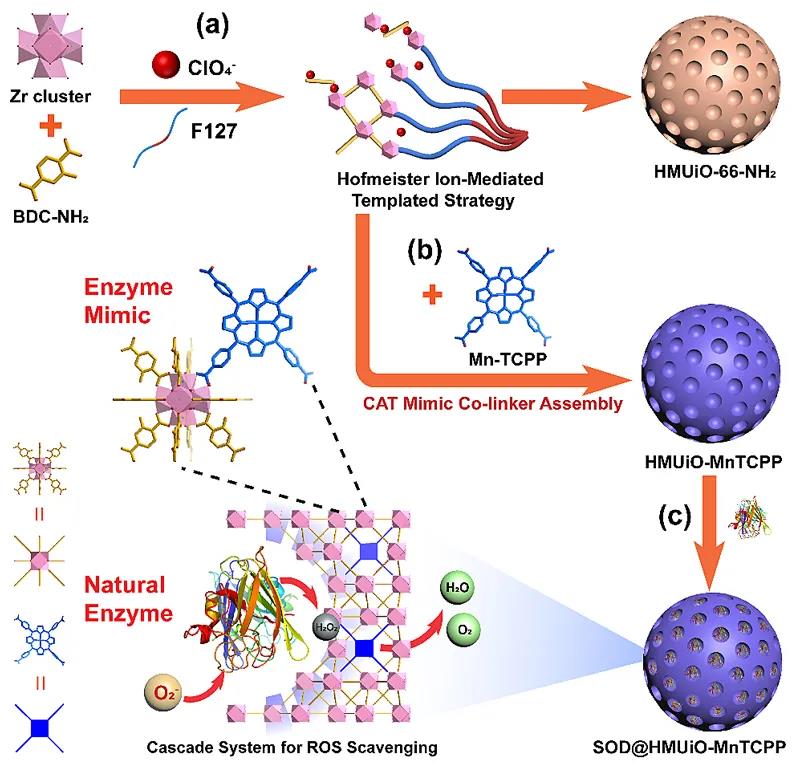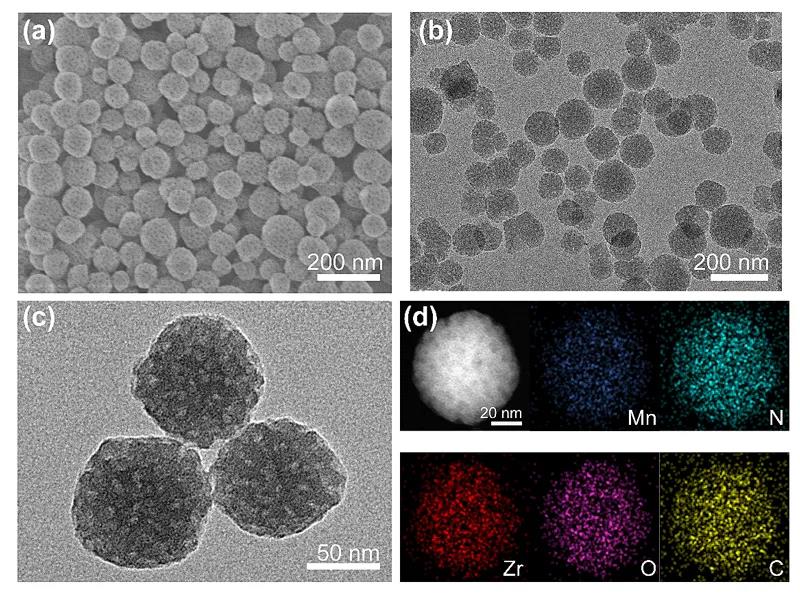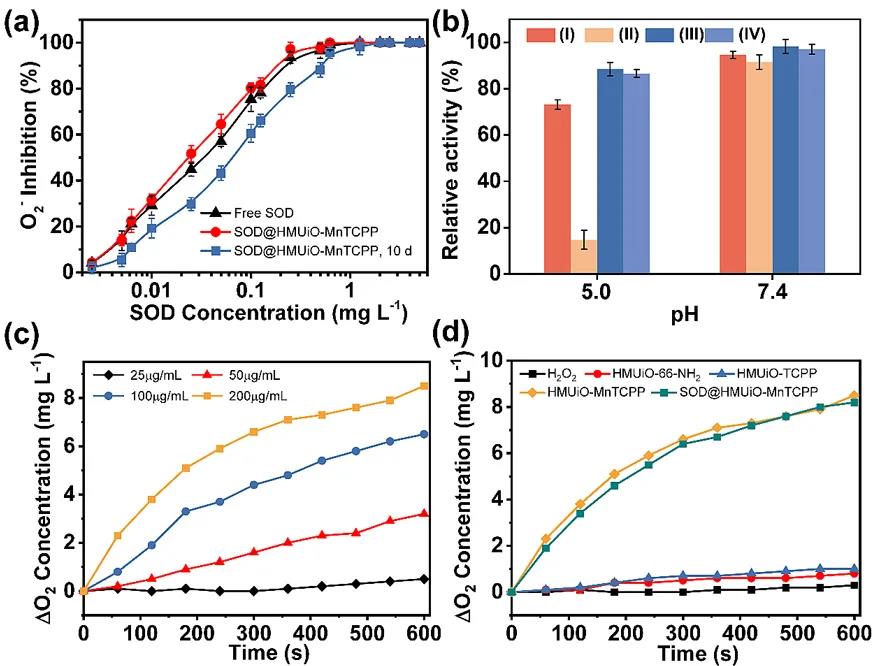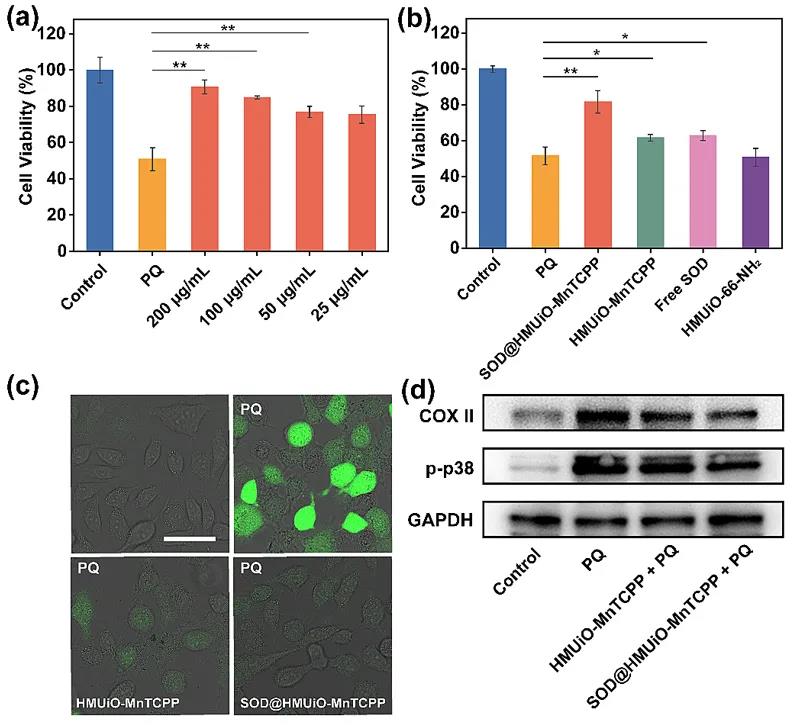East China University of Science and Technology Gu Jinlou "CM": Positioning and construction of cascade bioreactors in the pores of nano mesoporous MOFs and their use in the removal of intracellular r
Compartmentalization and cascade reactions in the living body are the basic principles for realizing intracellular metabolism and efficient information exchange in nature. This method can allow efficient and directional transfer of intermediate products between various catalytic units. Therefore, the simulation of this efficient and orderly nano-microenvironment in artificial systems has aroused great interest. At present, a variety of bioreactors based on porous materials have been developed, and it is hoped that the catalytic effects of different enzymes can be efficiently coupled. The highly adjustable structure and variable composition of metal organic frameworks (MOFs) make them ideal materials for constructing such bioreactors. The advantage of MOFs is not only that the physical structure can be designed and the mesoporous structure can be introduced to load the macromolecular enzyme, but also the chemical composition on the pore wall can be changed to give it a catalytic effect that can be synergistic with the enzyme. However, it is still a challenge to use soft templates as structure directing agents in MOFs to self-assemble to form mesopores while maintaining their crystallinity. This is because the driving force of crystallization during the growth of MOFs is usually very strong, so the precursor tends to crystallize preferentially, and the template is excluded from the self-assembly process, making it unable to play a structure-oriented role.
In response to the above problems, the team of Professor Gu Jinlou of East China University of Science and Technology developed a Hofmeister ion-mediated soft template self-assembly strategy based on the previous research, and realized the controllable synthesis of mesoporous MOFs, and on this basis The micro mesoporous structure of MOFs is hierarchically functionalized, and a nano-scale coupled bioreactor is successfully constructed for the removal of active oxygen in cells. As shown in Figure 1, the author used UiO-66 type MOF as the matrix, F127 as the template, and ClO4- as the salt-soluble ion to synthesize nano mesoporous MOFs with a pore size of about 7 nm. At the same time, thanks to the diversity of the coordination modes of the Zr6 clusters, the manganese porphyrin molecule with catalase (CAT) activity can be introduced into the framework as a ligand, which is compatible with the natural superoxide dismutase loaded in the mesopores. (SOD) synergistic action constitutes a cascade antioxidant system for efficient removal of intracellular reactive oxygen species (ROS).

Figure 1. Schematic diagram of constructing spatially functionalized bioreactors in mesoporous MOFs to remove reactive oxygen species in cells.
The research team first revealed the main influencing factors of the self-assembly strategy by adjusting the parameters of the reaction system. First, as a Hofmeister salt-soluble ion, ClO4- plays a key role in the formation of mesopores in this system. The role of ClO4- is to enhance the interaction between the MOFs precursor and the copolymer micelles, thereby preventing the phase separation of the copolymer micelles and MOFs precursors in the self-assembly system. Without ClO4-, only UiO-66-NH2 without mesopores can be obtained. Secondly, the amount of modifier is a key factor to control the mesoporous structure and morphology of nanoparticles. A series of control experiments show that when the amount of modifier is small, the obtained nanoparticles are smaller, but the crystallinity of the product is lower. When the amount of regulator added is too much, the particle shape will become irregular and the size will increase, which is not conducive to the endocytosis of cells in subsequent experiments.
The author used scanning electron microscopy, transmission electron microscopy, nitrogen adsorption test, and scanning transmission electron microscopy to characterize the material in detail. The results show that the material has a mesopore size of about 7.4 nm and a particle size of about 100 nm (Figure 2), and the morphology and structure of the material do not change significantly after doping with porphyrin ligands (Figure 3).

Figure 2. Typical SEM (a) and TEM (b) images of HMUiO-66-NH2. (C) XRD patterns of HMUiO-66-NH2, HMUiO-MnTCPP and simulated UiO-66. (D) N2 adsorption isotherms of HMUiO-66-NH2 (red) and HMUiO-MnTCPP (blue) and their corresponding BJH pore size distributions.

Figure 3. Typical SEM (a) and TEM (b, c) images of HMUiO-MnTCPP. (D) STEM images and element distribution diagrams of Mn, N, Zr, O, and C of the synthesized HMUiO-MnTCPP.
The results of in vitro experiments show that the mesoporous MOFs as a carrier can provide good protection to the loaded SOD. After soaking in the buffer for a period of time, SOD@HMUiO-MnTCPP still has higher O2-inhibitory activity than free SOD (Figure 4a, b). At the same time, the doped Mn-TCPP ligand imparts HMUiO-MnTCPP-like CAT activity, which can further decompose the H2O2 produced by SOD-catalyzed O2- into H2O and O2 (Figure 4c, d).

Figure 4. (a, b) SOD activity and (c, d) CAT activity of HMUiO MOFs.
Subsequently, the team used paraquat (PQ) as an oxidative stressor to stimulate the overexpression of ROS in HeLa cells, and used this as a model to test the protective ability of the antioxidant system on cells. As shown in Figures 5a and 5b, the effect of SOD@HMUiO-MnTCPP on cell viability is positively correlated with dose. At the same time, compared with untreated cells, the cell survival rate of HMUiO-MnTCPP and free SOD treatment groups only slightly increased. It shows that the natural SOD and simulated CAT enzyme in SOD@HMUiO-MnTCPP have a synergistic effect on ROS clearance, so that the nanosystem has a more significant level of antioxidant protection. In order to further monitor the content of ROS in cells treated with different MOFs, the 2’,7’-dichlorofluorescein diacetic acid (DCFH-DA) method was used for testing. HeLa cells pretreated with PQ can produce significant fluorescence enhancement in laser confocal scanning microscopy (CLSM) imaging, which corresponds to the high level of ROS in the cells (Figure 5c). The fluorescence of the cells pretreated with SOD@HMUiO-MnTCPP was significantly reduced, which further proved the outstanding ability of the system to eliminate ROS. In addition, p-p38 and COX-II produced by oxidative stress were selected as biomarkers to further evaluate the antioxidant capacity of the nanosystem. Western Blot results showed that in the SOD@HMUiO-MnTCPP treatment group, the expression levels of intracellular p-p38 and COX II were significantly reduced, again indicating that the designed and synthesized functionalized bioreactor has the ability to clear intracellular O2- and H2O2 , Can effectively protect cells from oxidative damage (Figure 5d).

Figure 5. Antioxidant ability in HMUiO MOFs cells: (a, b) cell viability experiment; (c) laser confocal image; (d) Western Blot experiment results.
Related papers were published on Chemistry of Materials. Doctoral student Li Ke from East China University of Science and Technology is the first author of the article, and Professor Gu Jinlou is the corresponding author.
In response to the above problems, the team of Professor Gu Jinlou of East China University of Science and Technology developed a Hofmeister ion-mediated soft template self-assembly strategy based on the previous research, and realized the controllable synthesis of mesoporous MOFs, and on this basis The micro mesoporous structure of MOFs is hierarchically functionalized, and a nano-scale coupled bioreactor is successfully constructed for the removal of active oxygen in cells. As shown in Figure 1, the author used UiO-66 type MOF as the matrix, F127 as the template, and ClO4- as the salt-soluble ion to synthesize nano mesoporous MOFs with a pore size of about 7 nm. At the same time, thanks to the diversity of the coordination modes of the Zr6 clusters, the manganese porphyrin molecule with catalase (CAT) activity can be introduced into the framework as a ligand, which is compatible with the natural superoxide dismutase loaded in the mesopores. (SOD) synergistic action constitutes a cascade antioxidant system for efficient removal of intracellular reactive oxygen species (ROS).

Figure 1. Schematic diagram of constructing spatially functionalized bioreactors in mesoporous MOFs to remove reactive oxygen species in cells.
The research team first revealed the main influencing factors of the self-assembly strategy by adjusting the parameters of the reaction system. First, as a Hofmeister salt-soluble ion, ClO4- plays a key role in the formation of mesopores in this system. The role of ClO4- is to enhance the interaction between the MOFs precursor and the copolymer micelles, thereby preventing the phase separation of the copolymer micelles and MOFs precursors in the self-assembly system. Without ClO4-, only UiO-66-NH2 without mesopores can be obtained. Secondly, the amount of modifier is a key factor to control the mesoporous structure and morphology of nanoparticles. A series of control experiments show that when the amount of modifier is small, the obtained nanoparticles are smaller, but the crystallinity of the product is lower. When the amount of regulator added is too much, the particle shape will become irregular and the size will increase, which is not conducive to the endocytosis of cells in subsequent experiments.
The author used scanning electron microscopy, transmission electron microscopy, nitrogen adsorption test, and scanning transmission electron microscopy to characterize the material in detail. The results show that the material has a mesopore size of about 7.4 nm and a particle size of about 100 nm (Figure 2), and the morphology and structure of the material do not change significantly after doping with porphyrin ligands (Figure 3).

Figure 2. Typical SEM (a) and TEM (b) images of HMUiO-66-NH2. (C) XRD patterns of HMUiO-66-NH2, HMUiO-MnTCPP and simulated UiO-66. (D) N2 adsorption isotherms of HMUiO-66-NH2 (red) and HMUiO-MnTCPP (blue) and their corresponding BJH pore size distributions.

Figure 3. Typical SEM (a) and TEM (b, c) images of HMUiO-MnTCPP. (D) STEM images and element distribution diagrams of Mn, N, Zr, O, and C of the synthesized HMUiO-MnTCPP.
The results of in vitro experiments show that the mesoporous MOFs as a carrier can provide good protection to the loaded SOD. After soaking in the buffer for a period of time, SOD@HMUiO-MnTCPP still has higher O2-inhibitory activity than free SOD (Figure 4a, b). At the same time, the doped Mn-TCPP ligand imparts HMUiO-MnTCPP-like CAT activity, which can further decompose the H2O2 produced by SOD-catalyzed O2- into H2O and O2 (Figure 4c, d).

Figure 4. (a, b) SOD activity and (c, d) CAT activity of HMUiO MOFs.
Subsequently, the team used paraquat (PQ) as an oxidative stressor to stimulate the overexpression of ROS in HeLa cells, and used this as a model to test the protective ability of the antioxidant system on cells. As shown in Figures 5a and 5b, the effect of SOD@HMUiO-MnTCPP on cell viability is positively correlated with dose. At the same time, compared with untreated cells, the cell survival rate of HMUiO-MnTCPP and free SOD treatment groups only slightly increased. It shows that the natural SOD and simulated CAT enzyme in SOD@HMUiO-MnTCPP have a synergistic effect on ROS clearance, so that the nanosystem has a more significant level of antioxidant protection. In order to further monitor the content of ROS in cells treated with different MOFs, the 2’,7’-dichlorofluorescein diacetic acid (DCFH-DA) method was used for testing. HeLa cells pretreated with PQ can produce significant fluorescence enhancement in laser confocal scanning microscopy (CLSM) imaging, which corresponds to the high level of ROS in the cells (Figure 5c). The fluorescence of the cells pretreated with SOD@HMUiO-MnTCPP was significantly reduced, which further proved the outstanding ability of the system to eliminate ROS. In addition, p-p38 and COX-II produced by oxidative stress were selected as biomarkers to further evaluate the antioxidant capacity of the nanosystem. Western Blot results showed that in the SOD@HMUiO-MnTCPP treatment group, the expression levels of intracellular p-p38 and COX II were significantly reduced, again indicating that the designed and synthesized functionalized bioreactor has the ability to clear intracellular O2- and H2O2 , Can effectively protect cells from oxidative damage (Figure 5d).

Figure 5. Antioxidant ability in HMUiO MOFs cells: (a, b) cell viability experiment; (c) laser confocal image; (d) Western Blot experiment results.
Related papers were published on Chemistry of Materials. Doctoral student Li Ke from East China University of Science and Technology is the first author of the article, and Professor Gu Jinlou is the corresponding author.
18915694570
Previous: Xian Jiaotong Universi


